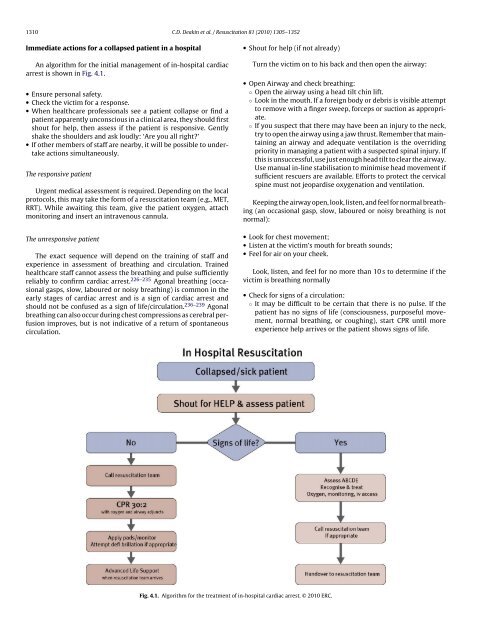European Resuscitation Council Guidelines for Resuscitation 2010 ...
European Resuscitation Council Guidelines for Resuscitation 2010 ...
European Resuscitation Council Guidelines for Resuscitation 2010 ...
You also want an ePaper? Increase the reach of your titles
YUMPU automatically turns print PDFs into web optimized ePapers that Google loves.
1310 C.D. Deakin et al. / <strong>Resuscitation</strong> 81 (<strong>2010</strong>) 1305–1352<br />
Immediate actions <strong>for</strong> a collapsed patient in a hospital<br />
An algorithm <strong>for</strong> the initial management of in-hospital cardiac<br />
arrest is shown in Fig. 4.1.<br />
• Ensure personal safety.<br />
• Check the victim <strong>for</strong> a response.<br />
• When healthcare professionals see a patient collapse or find a<br />
patient apparently unconscious in a clinical area, they should first<br />
shout <strong>for</strong> help, then assess if the patient is responsive. Gently<br />
shake the shoulders and ask loudly: ‘Are you all right?’<br />
• If other members of staff are nearby, it will be possible to undertake<br />
actions simultaneously.<br />
The responsive patient<br />
Urgent medical assessment is required. Depending on the local<br />
protocols, this may take the <strong>for</strong>m of a resuscitation team (e.g., MET,<br />
RRT). While awaiting this team, give the patient oxygen, attach<br />
monitoring and insert an intravenous cannula.<br />
The unresponsive patient<br />
The exact sequence will depend on the training of staff and<br />
experience in assessment of breathing and circulation. Trained<br />
healthcare staff cannot assess the breathing and pulse sufficiently<br />
reliably to confirm cardiac arrest. 226–235 Agonal breathing (occasional<br />
gasps, slow, laboured or noisy breathing) is common in the<br />
early stages of cardiac arrest and is a sign of cardiac arrest and<br />
should not be confused as a sign of life/circulation. 236–239 Agonal<br />
breathing can also occur during chest compressions as cerebral perfusion<br />
improves, but is not indicative of a return of spontaneous<br />
circulation.<br />
• Shout <strong>for</strong> help (if not already)<br />
Turn the victim on to his back and then open the airway:<br />
• Open Airway and check breathing:<br />
◦ Open the airway using a head tilt chin lift.<br />
◦ Look in the mouth. If a <strong>for</strong>eign body or debris is visible attempt<br />
to remove with a finger sweep, <strong>for</strong>ceps or suction as appropriate.<br />
◦ If you suspect that there may have been an injury to the neck,<br />
try to open the airway using a jaw thrust. Remember that maintaining<br />
an airway and adequate ventilation is the overriding<br />
priority in managing a patient with a suspected spinal injury. If<br />
this is unsuccessful, use just enough head tilt to clear the airway.<br />
Use manual in-line stabilisation to minimise head movement if<br />
sufficient rescuers are available. Ef<strong>for</strong>ts to protect the cervical<br />
spine must not jeopardise oxygenation and ventilation.<br />
Keeping the airway open, look, listen, and feel <strong>for</strong> normal breathing<br />
(an occasional gasp, slow, laboured or noisy breathing is not<br />
normal):<br />
• Look <strong>for</strong> chest movement;<br />
• Listen at the victim’s mouth <strong>for</strong> breath sounds;<br />
• Feel <strong>for</strong> air on your cheek.<br />
Look, listen, and feel <strong>for</strong> no more than 10 s to determine if the<br />
victim is breathing normally<br />
• Check <strong>for</strong> signs of a circulation:<br />
◦ It may be difficult to be certain that there is no pulse. If the<br />
patient has no signs of life (consciousness, purposeful movement,<br />
normal breathing, or coughing), start CPR until more<br />
experience help arrives or the patient shows signs of life.<br />
Fig. 4.1. Algorithm <strong>for</strong> the treatment of in-hospital cardiac arrest. © <strong>2010</strong> ERC.
















